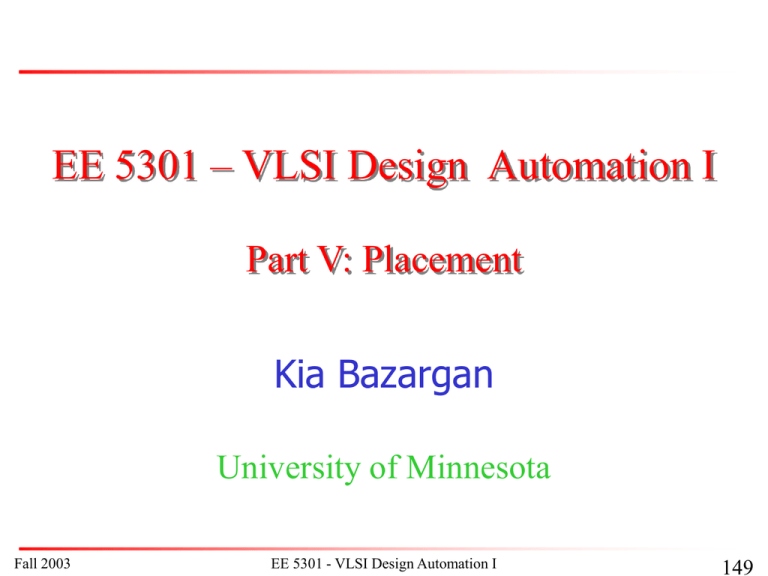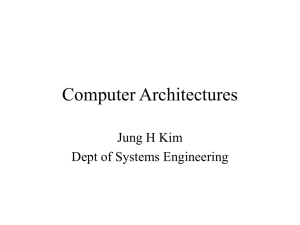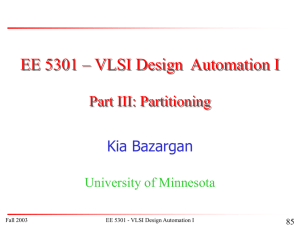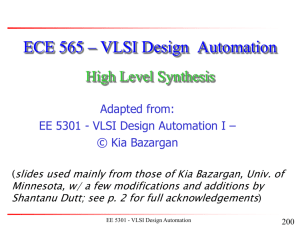PowerPoint Presentation: EE5301- Floorplanning
advertisement

EE 5301 – VLSI Design Automation I Part V: Placement Kia Bazargan University of Minnesota Fall 2003 EE 5301 - VLSI Design Automation I 149 References and Copyright • Textbooks referred (none required) [Mic94] G. De Micheli “Synthesis and Optimization of Digital Circuits” McGraw-Hill, 1994. [CLR90] T. H. Cormen, C. E. Leiserson, R. L. Rivest “Introduction to Algorithms” MIT Press, 1990. [Sar96] M. Sarrafzadeh, C. K. Wong “An Introduction to VLSI Physical Design” McGraw-Hill, 1996. [She99] N. Sherwani “Algorithms For VLSI Physical Design Automation” Kluwer Academic Publishers, 3rd edition, 1999. Fall 2003 EE 5301 - VLSI Design Automation I 150 References and Copyright (cont.) • Slides used: (Modified by Kia when necessary) [©Sarrafzadeh] © Majid Sarrafzadeh, 2001; Department of Computer Science, UCLA [©Sherwani] © Naveed A. Sherwani, 1992 (companion slides to [She99]) [©Keutzer] © Kurt Keutzer, Dept. of EECS, UC-Berekeley http://www-cad.eecs.berkeley.edu/~niraj/ee244/index.htm [©Gupta] © Rajesh Gupta UC-Irvine http://www.ics.uci.edu/~rgupta/ics280.html [©Kang] © Steve Kang UIUC http://www.ece.uiuc.edu/ece482/ Fall 2003 EE 5301 - VLSI Design Automation I 151 Placement • Problem Given a netlist, and fixed-shape cells (small, standard cell), find the exact location of the cells to minimize area and wire-length Consistent with the standard-cell design methodology o Row-based, no hard-macros Modules: o Usually fixed, equal height (exception: double height cells) o Some fixed (I/O pads) o Connected by edges or hyperedges • Objectives Cost components: area, wire length o Additional cost components: timing, congestion Fall 2003 EE 5301 - VLSI Design Automation I 152 Placement Cost Components • Area Would like to pack all the modules very tightly • Wire length (half-perimeter of the hnet bbox) Minimize the average wire length Would result in tight packing of the modules with high connectivity • Overlap Could be prohibited by the moves, or used as penalty Keep the cells from overlapping (moves cells apart) • Timing Not a 1-1 correspondent with wire length minimization, but consistent on the average • Congestion Measure of routability Would like to move the cells apart Fall 2003 EE 5301 - VLSI Design Automation I 153 Placement Algorithms • Top-Down Partitioning-based placement Recursive bi-partitioning or quadrisection A 1 2 B o Cut direction? o Partition vs. physical location • Iterative Simulated annealing OR: Force directed Start with an initial placement, iteratively improve the wire-length and area C • Constructive Start with a few cells in the center, and place highly connected adjacent modules around them Fall 2003 EE 5301 - VLSI Design Automation I A L D F H B G 154 Simulated Annealing Placement • Cost Area (usually fixed # of rows, variable row width) Wirelength (Euclidian or Manhattan) Cell overlap (penalty increases with temperature) • Moves Exchange two cells within a radius R (R temperature dependent?) Displace a cell within a row Flip a cell horizontally • Low vs. High temperature If used as a post processing, start with low-temp • Post-processing? Might be needed if there are still overlaps Fall 2003 EE 5301 - VLSI Design Automation I 155 Force-Directed Placement • Model Wires simulated as springs (if the only force, what will happen?) Forceij = Weightij x distanceij. Cell sizes as repellant forces [Eisenmann, DAC’98]: “vacant” regions work as “attracting” forces “overcrowded” regions work as “repelling” forces • Algorithm Solve a set of linear equations to find an intermediate solution (module locations) Repeat the process until equilibrium Fall 2003 EE 5301 - VLSI Design Automation I 156 Force-Directed Placement (cont.) • Model (details): Cell distances: either xij | xi x j | OR: yij | yi y j | dij ( xi x j ) ( yi y j ) 2 2 Forces: n F (kij xij ) i x j 1 n F (kij yij ) i y j 1 Objective: find x,y coordinates for all cells such that total force exerted on each cell is zero. Fall 2003 EE 5301 - VLSI Design Automation I 157 Force-Directed Placement (cont.) • Avoiding overlaps or collapsing in one point? Use fixed boundary I/O cells Use repelling force between cells that are not connected by a net Do not allow a move that results in overlap Use repelling “field” forces from congested areas to sparse ones [Eisenmann, DAC’98] n i Fx (kij xij ) Ex ( xi , yi ) j 1 • Problems with force directed: Overlap still might occur (cell sizes model artificially) Flat design, not hierarchy Fall 2003 EE 5301 - VLSI Design Automation I 158 Partitioning-based Placement • Simultaneously perform: Circuit partitioning Chip area partitioning Assign circuit partitions to chip slots • Problem: Circuit partitioning unaware of the physical location B A B A Solution: Terminal propagation (add dummy terminals) A B A B [She99] p.239 Fall 2003 EE 5301 - VLSI Design Automation I 159 Partitioning-based Placement • More problems: Direction of the cut? [Yildiz, DAC’01] 1 4 2 6 3 5 2 7 4 (a) 1 3 5 (b) 5 6 7 8 9 1 2 1 2 3 4 (c) 3 (d) How to handle fixed blocks? (area assigned to a partition might not be enough) How to correct a bad decision made at a higher level? • Advantages: Hierarchical, scalable Inherently apt for congestion minimization, easily extendable to timing optimization Fall 2003 EE 5301 - VLSI Design Automation I 160 To Probe Further... • Hans Eisenmann and Frank M. Johannes “Generic Global Placement and Floorplanning”, Design Automation Conference (DAC), pp. 269-274, 1998. (force directed method) • Maogang Wang, Xiaojian Yang and Majid Sarrafzadeh “Dragon2000: Standard-Cell Placement Tool for Large Industry Circuits”, International Conference on Computer-Aided Design (ICCAD), pp. 260-263, 2000. (partitioning-based placement) • Dennis J.-H. Huang and Andrew B. Kahng “Partitioning-based Standard-cell Global Placement With An Exact Objective”, International Symposium on Physical Design (ISPD), pp. 18-25, 1997. (quadrisection-based placement) Fall 2003 EE 5301 - VLSI Design Automation I 161 To Probe Further... • Xiaojian Yang, Elaheh Bozorgzadeh and Majid Sarrafzadeh, “Wirelength Estimation based on Rent Exponents of Partitioning and Placement”, System Level Interconnect Prediction (SLIP), pp. 25-31, 2001. • Mehmet Can Yildiz and Patrick H. Madden “Improved Cut Sequences for Partitioning Based Placement”, Design Automation Conference (DAC), pp. 776-779, 2001. (cut directions in partitioning-based placement) • Chandra Mulpuri and Scott Hauck “Runtime and Quality Tradeoffs in FPGA Placement and Routing”, International Symposium on Field Programmable Gate Arrays (FPGA), pp. 29-36, 2001. (placement and routing quality/speed trade-off) Fall 2003 EE 5301 - VLSI Design Automation I 162








